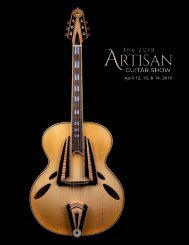2018 AGS Magazine
Magazine for the 2018 Artisan Guitar Show
Magazine for the 2018 Artisan Guitar Show
You also want an ePaper? Increase the reach of your titles
YUMPU automatically turns print PDFs into web optimized ePapers that Google loves.
intended to increase both volume and projection.<br />
The development of the archtop guitar has truly<br />
been an evolutionary process with much experimentation<br />
involved for very practical reasons.<br />
As an example, when guitars were introduced to<br />
orchestras around the beginning of the twentieth<br />
century there was no amplification. Larger guitar<br />
bodies allowed greater sonic force so that guitar<br />
players were not lost in the<br />
There is very real<br />
science involved in<br />
building a guitar.<br />
mix and level of sound created<br />
by a big band. In order to<br />
enhance volume and projection,<br />
guitar makers began to<br />
experiment with body size<br />
and style.<br />
The variations in f-hole versus round or oval<br />
soundholes were also practical. Instruments with<br />
round or oval sound holes can have a very<br />
different sound than those with f-holes.<br />
Volume, timbre, and<br />
the “punch”<br />
of a note<br />
1963 Ferrari GT<br />
California Spyder<br />
are all impacted by the soundhole. The same is<br />
true of bracing, wood selections, bridge height<br />
adjustment, and the myriad of techniques and<br />
materials that effect tone and intonation. There<br />
is very real science involved in building a guitar.<br />
In the case of the archtop guitar as an acoustic<br />
instrument, there were many considerations that<br />
drove innovation. When electrification and amplification<br />
were introduced, the design nuances all<br />
changed again.<br />
The Gibson story has been told many times and<br />
there is no need to say more than the demand for<br />
the work of Orville Gibson greatly surpassed his<br />
ability to supply guitars and mandolins. The result<br />
of that supply-demand imbalance combined with<br />
a few other factors was that a group of investors<br />
ultimately gained control of the Gibson Guitar<br />
Company brand in 1904. What happened to the<br />
involvement of Orville Gibson after that is some<br />
combination of myth and lore. Most<br />
Bill Comins<br />
Ivy Rose Side Port Detail




